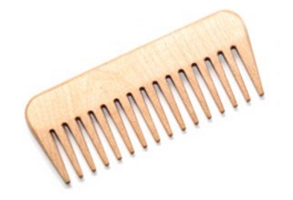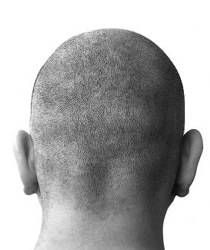
Counting Hair For Hair Loss
If you want to know how much hair you're really losing, a past issue of The Archives of Dermatology reported on a method for answering that question.
Dr. Jeffrey Miller, the senior author of the study and associate professor of dermatology at Penn State College of Medicine in Hershey, Pennsylvania, created a simple and reliable "60-second hair count".
Counting Hair For Hair Loss
It lets anyone determine whether they're balding or not. If balding occurs, the hair count lets you know how fast it's happening.The key is to count the hairs on your comb or brush but not on your head.
The results may or may not be reassuring, but at least it provides a baseline before any hair loss treatments are undertaken.
50% Of Men And Women Experience Some Hair Loss By The Age Of 50
Any type of hair loss is emotional, and it's worse if you don't really know whether the loss is temporary, permanent, or a figment of your imagination. Having a method for determining what's really happening provides some peace of mind and the opportunity to make decisions about options.
Hair loss is incredibly common among both men and women. Scientists and hair experts say that fifty percent of men and women will experience some type of hair loss by the age of 50.
Hair loss, especially when it's obvious, impacts several factors in life, including career, ability to date successfully, and overall perception by others.
Is Losing 100 Hairs A Day Normal?
 Although hair restoration experts and the hair media often state that shedding up to 100 hairs daily is normal, others believe that number is too high.
Although hair restoration experts and the hair media often state that shedding up to 100 hairs daily is normal, others believe that number is too high.
Unfortunately, like many hair-related matters, there is little scientific evidence to provide a rule of thumb over what is considered average.
There are too many factors to consider for scientists to deem a total number of hair that can be safely lost per day.
The current number of 100 lost hairs a day as average is usually based upon the general belief that the average scalp holds 100,000 hairs, 10 percent of which are at any one time thought to be in the telogen, or resting, phase.
A real question is, how normal is it to lose 100 hairs a day? Another critical question is what is expected in hair loss, and does the standard extend to all people of all races, ages, and sex?
Hair Loss Wash Test
Some dermatologists and hair loss experts recommend the Hair Loss Wash Test.
This test involves washing hair over a sink so that lost hair can be collected and counted five days between shampoo periods.
Some people have trouble with this method since it requires a waiting period of five days. Many feel the need to wash their hair on a daily basis.
 Physician Applied Low-Level Laser Light Therapy (LLLT)
Physician Applied Low-Level Laser Light Therapy (LLLT)The Archives of Dermatology study utilized the 60-second hair count. In the study, sixty healthy men aged 20 to 60 without any evidence of hair loss participated. All were white, and all but one had straight hair.
60-Second Hair Count
Men with long, curly, wavy, or textured hair were excluded. This was due to the possible difficulty of running a comb through textured strands.
Doing so might lead to an increase in the number of broken hair, which was not counted for purposes of determining hair loss.
Comb-And-Count Procedure
The men in the study washed their hair three mornings in a row with Neutrogena T/Sal shampoo.
On the fourth day, they were issued identical combs. Study subjects were instructed to comb their hair forward over a towel or pillowcase of contrasting color.
They were then asked to count the hairs that had dropped out.
This comb-and-count procedure was repeated for the next two days. The number of hairs was validated under a microscope. After six months, the participants repeated the full procedure.
Normal Hair Loss Numbers For Men By Age
Based on these results, the authors concluded that losing 10 hairs is "normal." In younger men (aged 20 to 40), the shedding range was 0 to 78 hairs.
The mean amount was 10.2 hairs. In the older men, the range was 0 to 43 hairs, with a mean of 10.3 hairs.
60 Second Hair Count Instructions
 Physician Applied Low-Level Laser Light Therapy (LLLT)
Physician Applied Low-Level Laser Light Therapy (LLLT)Comb hair for 60 seconds over a pillow or sheet of contrasting color before washing. Pull the comb from the back top of the scalp forward to the front of the scalp for 60 seconds.
Why 60 seconds? Dr. Miller explains, "That 60 seconds allows you to dislodge any of the resting hairs that are supposed to be shed,"
Repeat the procedure before three consecutive shampooing sessions, always using the same comb.
Count and record the number of hairs in the comb and on the pillow or sheet. Repeat the procedure every month and discuss the results with your hair restoration doctor.
The 60 Second Hair Count study was funded by Merck & Co.; Dr. Miller has received consulting fees from the drug company Pfizer Inc.
When To Start Panicking Over Hair Loss?
Dr. Miller counsels men who lose more than 50 hairs a day (as counted in the 60-second period) to check with their hair restoration physicians. "The hair acts like a window to the inside of the body," he said.
"If there's something going on inside the body that is not right, for example, low thyroid output or low iron, your hair can react by shedding more."
"If you notice that you're shedding a lot of hair on the 60-second hair count, it would be worthwhile to be evaluated by a physician to rule out underlying medical causes."
Sudden changes in the amount of hair you lose should also be evaluated, he said.
For more information on hair loss or hair restoration topics, visit the International Alliance of Hair Restoration Surgeons.
More InformationPlease follow me on Twitter at: http://Twitter.com/HairBoutique. I look forward to meeting new people from all walks of Twitter and learning from their Tweets. Visit us at Hairboutique.com, located at: http://www.HairBoutique.com, on Facebook, MySpace, and YouTube.
Thank you for visiting us at The HairBoutique Blog and for leaving your comments. They are very much appreciated. We apologize in advance but must remove any direct advertisements or solicitations.
Social Media Network Information
Please follow us on Twitter at: https://Twitter.com/HairBoutique. I look forward to meeting new people from all walks of Twitter and learning from their Tweets.

















